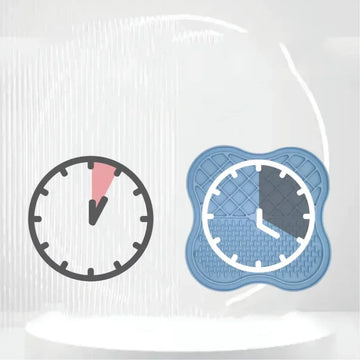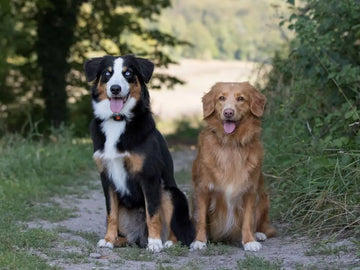Dogs are known for their enthusiastic eating habits, often devouring their meals in mere seconds. While this behavior might seem harmless, it can pose significant health risks to your canine companion. Slow feeders, designed to make dogs eat more slowly, offer a simple and effective solution. In this article, we’ll explore the key reasons why slow feeders are essential, the health benefits they provide, and how incorporating tools like the Pet Dog Slow Feeding Food Mat into your dog's routine can enhance their well-being.
Preventing Choking and Regurgitation
One of the immediate risks of rapid eating is choking. When a dog gulps down food too quickly, large pieces can get lodged in their throat, creating a life-threatening situation. Fast eating can also lead to regurgitation, where food is vomited shortly after ingestion. Slow feeders, including popular options like dog feeders with maze-like designs, force dogs to eat smaller bites, reducing the likelihood of choking or regurgitation. These tools encourage slower, more deliberate eating, giving dogs the time to chew properly.
Reducing the Risk of Bloat (Gastric Dilatation-Volvulus)
Bloat, or Gastric Dilatation-Volvulus (GDV), is a severe and potentially fatal condition in dogs. It occurs when the stomach fills with gas, fluid, or food, and then twists. Rapid eating increases the risk of bloat because dogs swallow large amounts of air alongside their food. Slow feeders are designed to slow down mealtime and reduce the amount of air swallowed, significantly lowering the risk of this dangerous condition.
Improving Digestion
Digestion begins in the mouth, where enzymes in saliva start breaking down food. Dogs that eat too quickly often skip this crucial step, swallowing large, unchewed pieces. This can lead to digestive issues such as upset stomachs, gas, and poor nutrient absorption. Using a slow feeder ensures that your dog chews their food thoroughly, allowing their digestive system to work more efficiently. Products from the best dog supplies category often prioritize ergonomic designs that encourage better chewing and digestion.
Promoting Healthy Eating Habits
Slow feeders are an excellent tool for promoting mindful eating habits in dogs. Just like humans benefit from eating slowly to feel fuller and more satisfied, dogs can experience similar advantages. By extending the duration of mealtime, slow feeders help dogs develop a healthier relationship with food. This reduces behaviors such as overeating or begging for more food. Slow feeders, such as durable dog feeders tailored to different breeds, are particularly useful for dogs prone to obesity or those on portion-controlled diets.
Providing Mental Stimulation
Dogs thrive on mental engagement, and slow feeders can serve as an enrichment activity. Many slow feeders, including the Pet Dog Slow Feeding Food Mat, are designed with intricate patterns or grooves that challenge dogs to use problem-solving skills to access their food. This added mental stimulation can reduce boredom, decrease anxiety, and tire out energetic dogs. By turning mealtime into a mentally engaging exercise, slow feeders promote a well-rounded approach to your dog’s health.
Addressing Breed-Specific Needs
Certain dog breeds are more prone to fast eating and its associated health risks. For example, deep-chested breeds like German Shepherds, Great Danes, and Boxers are at higher risk for bloat, making slow feeders especially beneficial for them. Similarly, breeds with insatiable appetites, like Labradors and Beagles, often benefit from slow feeders to control their eating speed. Incorporating tools like the specialized dog feeders can address these breed-specific needs effectively.
Aiding Puppies in Developing Good Eating Habits
Puppies are known for their unbridled enthusiasm at mealtime, often gobbling up food without chewing. Using a slow feeder from an early age helps puppies develop healthier eating habits that last a lifetime. Encouraging slow, mindful eating also prevents overeating, which is critical for healthy growth and development. Slow feeders available through best dog supplies are often designed to cater to puppies, ensuring safety and engagement during mealtime.
Choosing the Right Slow Feeder
When selecting a slow feeder for your dog, it’s important to consider their size, breed, and eating habits. Options like the Pet Dog Slow Feeding Food Mat are excellent for beginners, offering non-slip bases and intricate grooves to slow down even the fastest eaters. For large breeds, feeders with deeper grooves are ideal, while small breeds may benefit from more compact designs. Always opt for materials that are safe, such as BPA-free plastic, stainless steel, or ceramic.
Transitioning to a Slow Feeder
Introducing a slow feeder to your dog might require patience and encouragement. Start by placing small amounts of food in the feeder and guiding your dog to explore it. Treats or wet food can also help make the transition smoother. With consistent use, most dogs adapt to using slow feeders and come to enjoy the challenge it provides.
Conclusion
Slow feeders are more than just a solution for fast eaters—they are vital tools for improving your dog's health, safety, and overall well-being. By preventing choking, reducing the risk of bloat, aiding digestion, and promoting healthy eating habits, these feeders address various health concerns effectively. Beyond physical health, slow feeders also provide mental stimulation, turning mealtime into an enriching experience. For dogs prone to overeating, digestive issues, or boredom, incorporating the right dog feeders into their routine can make a significant difference. Explore options from best dog supplies to find the perfect slow feeder tailored to your dog’s unique needs and ensure they enjoy a healthier, happier life!










